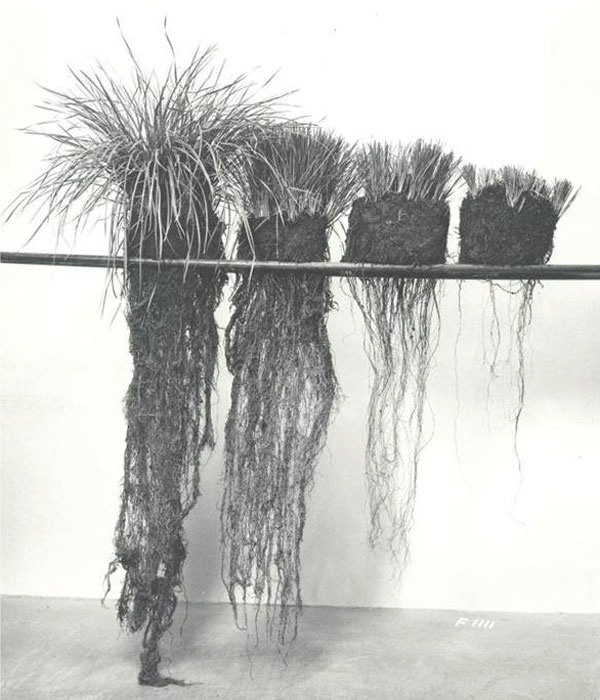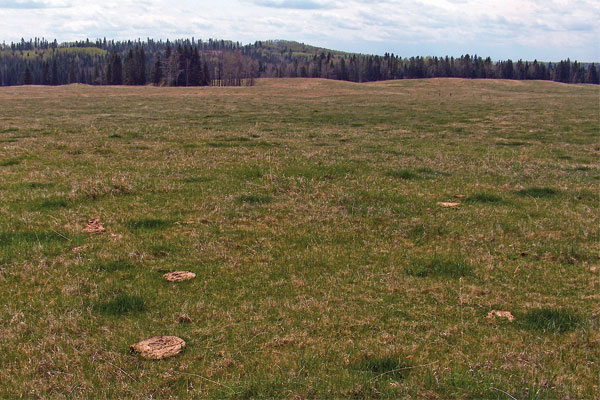Most of the forage plant is below the soil surface. We tend to think of the roots being there to support the top growth, but it’s kinda like the chicken and the egg thing—which comes first? The top growth acts as a solar panel harnessing the sun’s energy for photosynthesis to occur. The top growth is also the breathing mechanism for the plant. On the other side, there wouldn’t be any top growth without roots. The roots gather water and nutrients from the soil, as well as a whole lot of symbiotic relationships with a huge variety of soil microorganisms. We basically need to remember the concept: “No roots, no shoots” or “No shoots, no roots”.

In Figure 1, we can see the correlation between roots and top growth. At the far left is totally un-grazed grass while the far right sample is clipped quite short.
The root mass adjusts to match the top growth that can support it and the top growth won’t get any larger than what the roots are capable of supporting. Well, that’s not exactly true, top growth and roots will grow in proportion to each other.
When a grass plant is grazed severely, a proportionate amount of roots slough off. This isn’t a bad thing. It’s just the way it is. It’s the way grassland soils are replenished with organic matter. As long as the cycle of grazing and sufficient recovery time is followed, organic matter will be replenished. This is nature’s way.
This is how grasslands and pastures can be sustainable, both from an environmental perspective and an economic perspective. On pastures that are continuously grazed, or in any case where the grazing animals can graze plants before they have fully recovered from a previous graze, the roots will not re-grow sufficiently and the natural cycle that replenishes the soil organic matter becomes dysfunctional. When soil organic matter is reduced, the soil’s capacity for holding nutrients and water where they are available to plants is reduced and so, pasture productivity goes down, and continues to go down as long as plants don’t get enough time to recover.
Grasses, legumes and forbs (broad leafed plants of which some are commonly known as weeds) have different growth habits and root systems and understanding them helps us to make appropriate management decisions. A diverse mix of grasses, legumes and forbs makes a pasture more resilient to stresses such as drought, flooding, temperatures and grazing. Depending on which stress is the major factor, the plant community will shift towards species that are most resilient under that stressor. Take grazing, for example—if a pasture is grazed continuously through the whole growing season, over time, the plant community will shift toward those that can survive under frequent clipping. Highly productive, taller growing species would die off and be replaced with species like Kentucky Bluegrass and White Clover. Dandelions flourish on continuously grazed pastures. Common pasture weeds like Canada Thistle, Tall Buttercup, Scentless Chamomile and Wild Caraway would also take advantage of the opportunity to increase as the preferred pasture forage species diminish.
Depending on where you’re at, the common pasture weeds for your area will be the ones you’ll have to deal with. Did you notice, I didn’t include dandelions in with the common weeds? Dandelions are actually very nutritious forage plants, loaded with minerals and readily grazed by most grazing animals. When you start to see lots of tiny dandelions with even tinier grass plants in between them, the dandelions aren’t the problem. They are then a symptom of the problem, and part of the solution for the problem being, most likely nutrient deficiencies in the soil combined with over-grazing. Dandelions, with their long tap roots, bring minerals, particularly calcium from deep in the soil to the surface where they are again, accessible to the grasses and legumes. The presence of most of our “weeds” is in response to soil nutrient deficiencies, but we won’t dig into that any farther here. That’s a whole study all of its own …
You can read the whole article in the June/July 2013 issue of Canadian Cowboy Country magazine.
To subscribe, click here or call Kendra at 1-800-943-7336.

